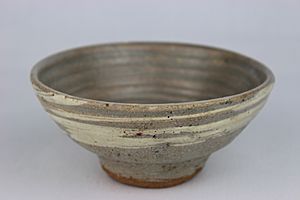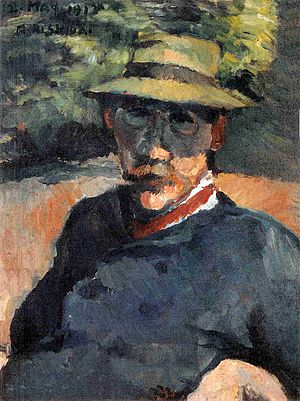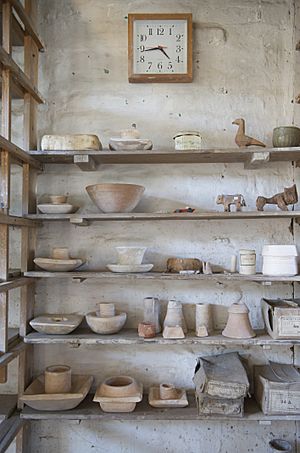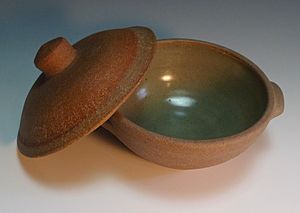Bernard Leach facts for kids
Quick facts for kids
Bernard Leach
|
|
|---|---|
 |
|
| Born | 5 January 1887 |
| Died | 6 May 1979 |
Bernard Howell Leach (born January 5, 1887 – died May 6, 1979) was a famous British studio potter and art teacher. Many people call him the "Father of British studio pottery" because he had such a big impact on pottery in Britain.
Contents
About Bernard Leach
Early Life and Discovering Pottery in Japan
Bernard Leach was born in Hong Kong. His mother passed away when he was born. He spent his first three years in Japan with his father. Later, he moved back to Hong Kong.
When he was older, Leach studied art in London. He learned how to make etchings, which are a type of printmaking. He became very interested in Japan after reading books about it. In 1909, he went back to Japan with his wife, Muriel. He planned to teach etching there.
While in Tokyo, he met many artists and writers. Around 1911, he went to a Raku-yaki pottery party. This was his first time seeing pottery being made, and he loved it! He decided to learn pottery from a master potter named Urano Shigekichi. This teacher was part of a long tradition of potters.
Leach started writing articles about pottery. He also designed covers for art magazines. In 1919, a young potter named Shōji Hamada visited Leach. Leach received a special kiln (a type of oven for firing pottery) and built it in a friend's garden. He named it Tōmon-gama. After becoming a skilled potter, he decided to move back to England.
Before leaving Japan in 1920, he had an art show in Osaka. He also had a farewell exhibition in Tokyo.
Starting the Leach Pottery in England
In 1920, Bernard Leach returned to England. He was invited by Frances Horne, who was setting up an arts and crafts group in St Ives, a town in Cornwall. Leach and his wife, along with his Japanese friend and fellow potter Shōji Hamada, found a good spot for a pottery studio.
They opened the Leach Pottery in 1920. They built a special Japanese kiln called a 'Noborigama'. This was the first time such a kiln was built in the Western world! It needed some repairs, but it helped them create amazing pottery.
Leach believed that pottery should combine ideas from both Western and Eastern art. He used traditional Korean, Japanese, and Chinese pottery styles. He also used old English and German techniques, like slipware (decorating with liquid clay) and salt glaze (a special way to make pottery shiny).
He saw pottery as more than just making things. For him, it was a mix of art, ideas, design, and craft. It was even a way of life! In 1940, he wrote a very important book called A Potter's Book. This book explained his ideas and techniques. It became very popular and helped him become well-known.
His Influence and Students
Bernard Leach believed in making pottery that was simple and useful. He called these "ethical pots." He thought pottery should be beautiful but also serve a purpose. His style became very popular in the 1940s and influenced modern design in North America during the 1950s and 1960s.
The Leach Pottery made many "standard ware" items. These were handmade pots for everyday people. But Leach also made special pots that were shown as works of art.
Many potters from all over the world came to learn at the Leach Pottery. They then shared Leach's style and ideas. Some of his famous students and friends include Michael Cardew, David Leach (his son), and Janet Leach (who he married in 1956). He also influenced many American and Canadian potters.
In 1952, Leach helped organize a big meeting for potters and weavers. This event brought together artists from different countries, including his friend Shoji Hamada from Japan. It helped to shape the modern studio pottery movement.
Later Years and Legacy
Bernard Leach kept making pottery until 1972. He loved to travel and explore different cultures. He even continued to write about ceramics after he started losing his eyesight.
In 1977, a major exhibition of his art was held at the Victoria and Albert Museum in London. The Leach Pottery is still open today in St Ives. It has a museum where you can see many beautiful pieces made by Leach and his students.
Awards and Recognition
Bernard Leach received many important awards for his work:
- Japan Foundation Cultural Award, 1974
- Companion of Honour, 1973 (UK)
- Order of the Sacred Treasure, 1966 (Japan)
- Commander of the Order of the British Empire, 1962
Images for kids
See also
 In Spanish: Bernard Leach para niños
In Spanish: Bernard Leach para niños












